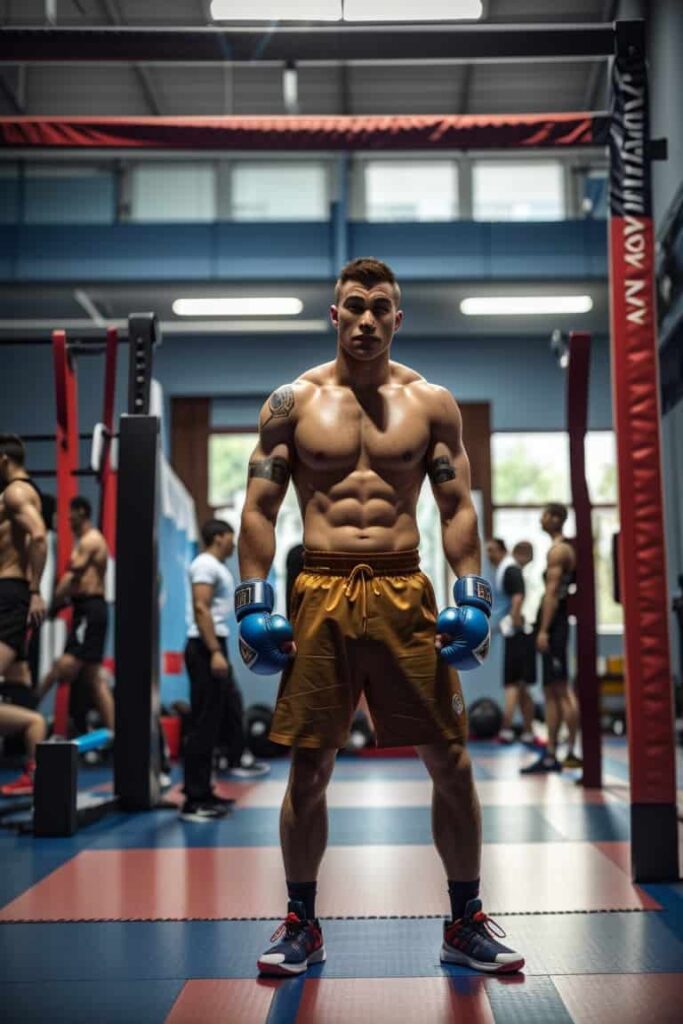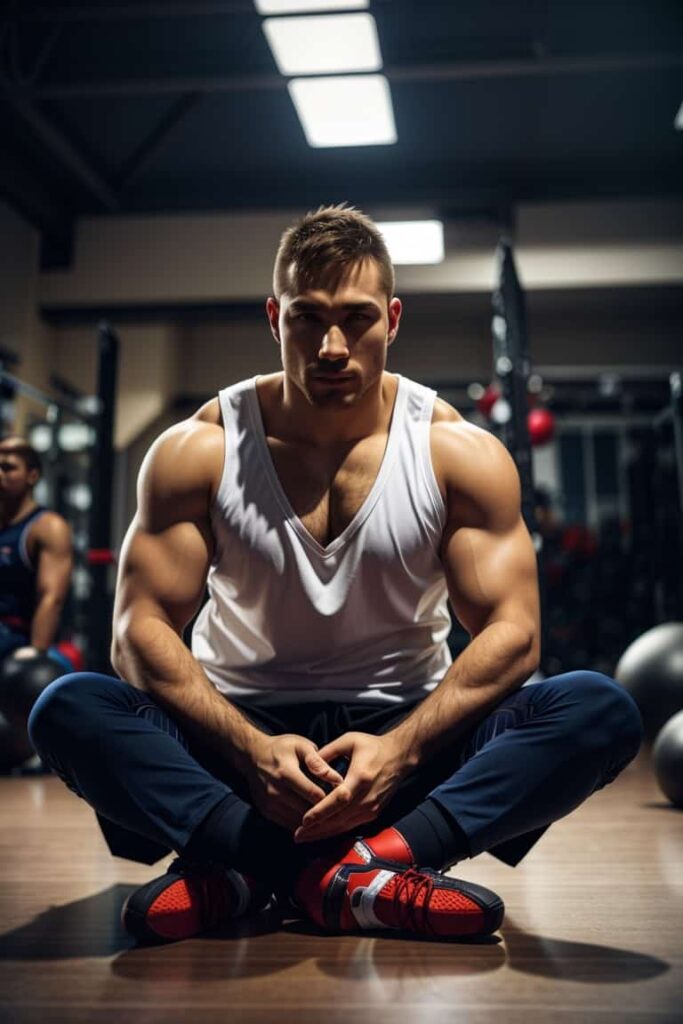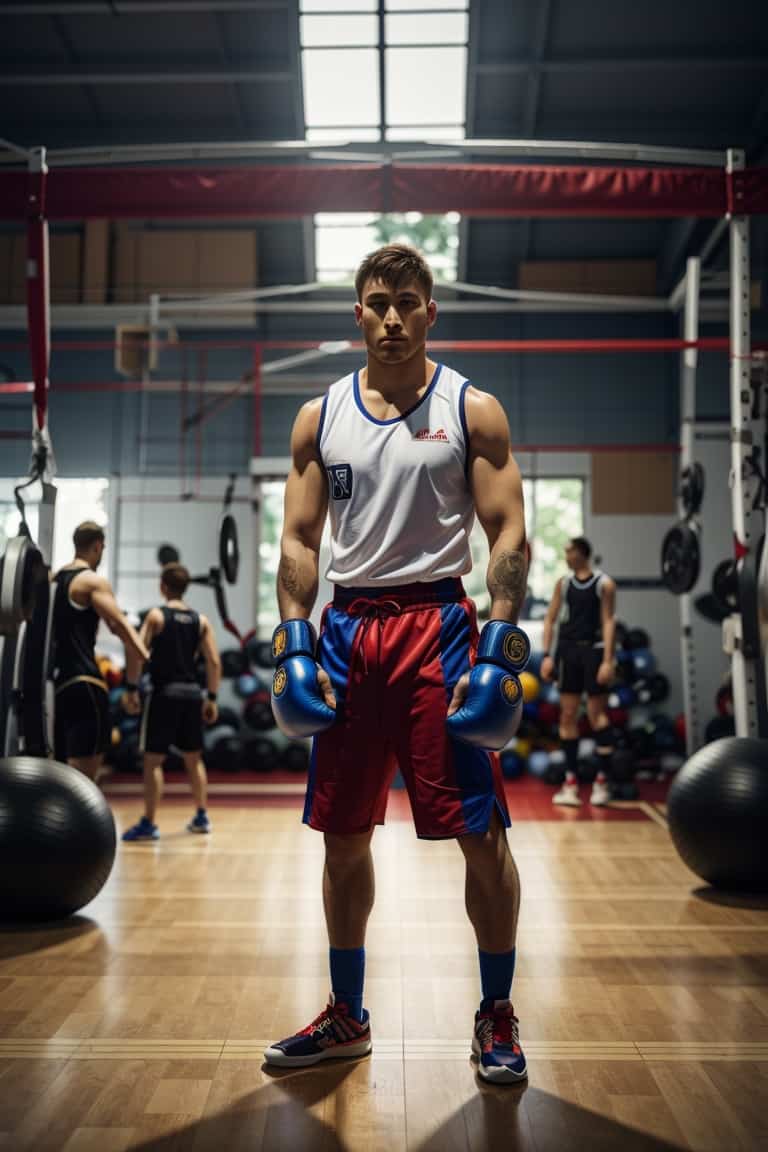In this article we look at the question of; ‘Do you wear shoes in Kickboxing?’ in order to help those grappling with the decision of whether to don footwear for kickboxing.
If you are taking a kickboxing class for the first time then it is fine to wear shoes to the class.
Don’t worry the instructor will tell you if you need to take off your shoes in order to participate or not.
Simple rule of thumb: if you are attending a cardio kickboxing class then shoes should be fine.
But if you are attending a kickboxing class at an MMA gym or fight academy then you probably will have to take your shoes off.
Historical Roots of Kickboxing and Barefoot Training
Kickboxing, like many martial arts, traces its origins to ancient times when combat techniques were developed for self-defense and warfare.
In its early forms, kickboxing, or a precursor thereof, was practiced barefoot.
This historical tradition stems from the practicality of training without shoes in the martial arts of the past.

In regions such as Thailand, where Muay Thai kickboxing emerged, fighters engaged in rigorous training and combat while barefoot.
This was not just a matter of convenience, but a reflection of the cultural and practical considerations of the time.
The absence of footwear allowed fighters to maintain a close connection to the ground, which was critical for stability and effective strikes.
French Kickboxing in Shoes
French kickboxing or Savate as it is known as, is probably the only kickboxing style where shoes are mandatory.
In Savate, practitioners wear specialized shoes known as “savate shoes” or “savate boots.”
These shoes are specifically designed to enhance the performance of kicking techniques while providing support and protection to the foot and ankle.
The toe area of Savate shoes is often reinforced with extra padding or a protective layer.
This reinforcement helps prevent injuries to the toes when delivering powerful kicks to an opponent’s body or head.
The Emergence of Kickboxing-Specific Shoes
In recent years, the world of kickboxing has witnessed the emergence of specialized footwear designed to cater to the unique demands of the sport.
These kickboxing-specific shoes have been developed to address the shortcomings of training barefoot, providing kickboxers with distinct advantages that enhance their performance and safety.
There are a few benefits to wearing shoes for kickboxing which are discussed below.
Ankle Support and Stability
One of the key advantages of kickboxing shoes is the added ankle support and stability they offer.
These shoes are designed with reinforced ankle areas to reduce the risk of sprains and injuries during training and competition.
The ankle support helps kickboxers maintain proper alignment during high-impact movements, such as pivots, jumps, and quick directional changes.

Cushioning for Shock Absorption
Kickboxing shoes are equipped with cushioning technology in the soles.
This cushioning serves as a shock absorber, reducing the impact on your joints, particularly the knees and ankles, when executing powerful kicks and footwork.
The added cushioning can contribute to reduced fatigue and fewer injuries, making it a valuable asset during intense training sessions.
Traction and Grip
Traction and grip are crucial aspects of kickboxing, especially when it comes to footwork and maintaining balance.
Kickboxing shoes are designed with outsoles that provide excellent traction on various surfaces, from mats to canvas rings.
This improved grip ensures you can execute your kicks and movements with confidence, without the risk of slipping or losing stability.
Types of shoes for Kickboxing
Low-Top vs. High-Top
Kickboxing shoes come in two primary styles: low-top and high-top.
Low-top shoes provide greater freedom of movement for the ankles and are favored by those who prioritize agility and speed. High-top shoes, on the other hand, offer more ankle support and stability, making them suitable for kickboxers who seek additional protection or have a history of ankle injuries.
The choice between low-top and high-top shoes often depends on your individual preferences and specific needs.
Lightweight vs. Heavyweight
Another consideration when selecting kickboxing shoes is the weight of the shoe itself.
Lightweight shoes are designed to minimize added weight and bulkiness, allowing for faster footwork and agility.
Conversely, heavyweight kickboxing shoes provide more durability and support but may reduce overall speed.
Your choice between these two options will depend on your training style and personal preferences.

Materials and Design Considerations
Kickboxing shoes are crafted using a variety of materials, including leather, synthetic materials, and mesh.
The choice of material can affect factors such as breathability, durability, and overall comfort.
Additionally, design elements, such as lacing systems and closure mechanisms, can impact how well the shoe fits and supports your feet during training.
As we explore the advantages and types of kickboxing shoes, it’s essential to weigh these benefits against the tradition and principles of barefoot training, as discussed in the previous section.
Ultimately, your choice of footwear in kickboxing should align with your training goals, individual preferences, and the specific demands of your training environment.
Training Environments and Regulations
A. Impact of Training Location on Footwear Choice
The choice of footwear in kickboxing can be greatly influenced by your training environment. Different locations, such as gyms, dojos, and open-air settings, may present unique challenges and considerations when deciding whether to wear shoes or train barefoot.
- Gym Training: Many kickboxing gyms have specific policies regarding footwear. Some gyms require kickboxers to wear specialized shoes for safety and hygiene reasons, especially when training on shared mats. In such cases, the impact of your training location can be a decisive factor in your choice of footwear.
- Outdoor Training: Training in outdoor environments, such as parks or open spaces, might necessitate a different approach. Here, the terrain can be less predictable, and the choice between shoes or barefoot training may depend on the surface you’re working on. Outdoor enthusiasts might prefer the adaptability of barefoot training to handle various natural surfaces.

B. Gym and Competition Regulations Regarding Kickboxing Shoes
In organized kickboxing competitions, specific regulations often dictate whether shoes are permitted and, if so, which types are allowed. These regulations are typically in place to ensure a level playing field and, more importantly, the safety of all participants.
- Gym Regulations: Kickboxing gyms may have their own set of rules regarding footwear during training sessions. Some gyms may insist on the use of kickboxing-specific shoes to minimize injury risks and maintain hygiene standards. Before joining a gym, it’s essential to familiarize yourself with its regulations and adapt your training attire accordingly.
- Competition Rules: When participating in kickboxing competitions, the rules regarding footwear can vary depending on the governing body and the specific ruleset of the event. In some competitions, wearing shoes may be mandatory, while others may permit barefoot fighting. Familiarizing yourself with the competition rules is crucial to ensure you comply with the footwear requirements.
C. Adapting to Different Environments
Kickboxers often find themselves training in diverse environments, each with its own challenges and advantages. To make the most informed decision regarding footwear, consider the following tips for adapting to different training environments:
- Flexibility: Be open to adapting your footwear choice based on the training location. Recognize that what works well in the gym may not be ideal for outdoor or competition settings.
- Foot Protection: Prioritize foot protection in situations where the training surface is rough, unclean, or poses a risk of injury. This might mean opting for kickboxing shoes or suitable protective gear.
- Compliance: Always adhere to gym and competition regulations. Disregarding these rules can result in disqualification or refusal of entry, impacting your training and competitive goals.
- Experiment: Don’t be afraid to experiment with different footwear options during training. This can help you discover what works best for you in various environments, allowing you to make informed choices when it matters most.



